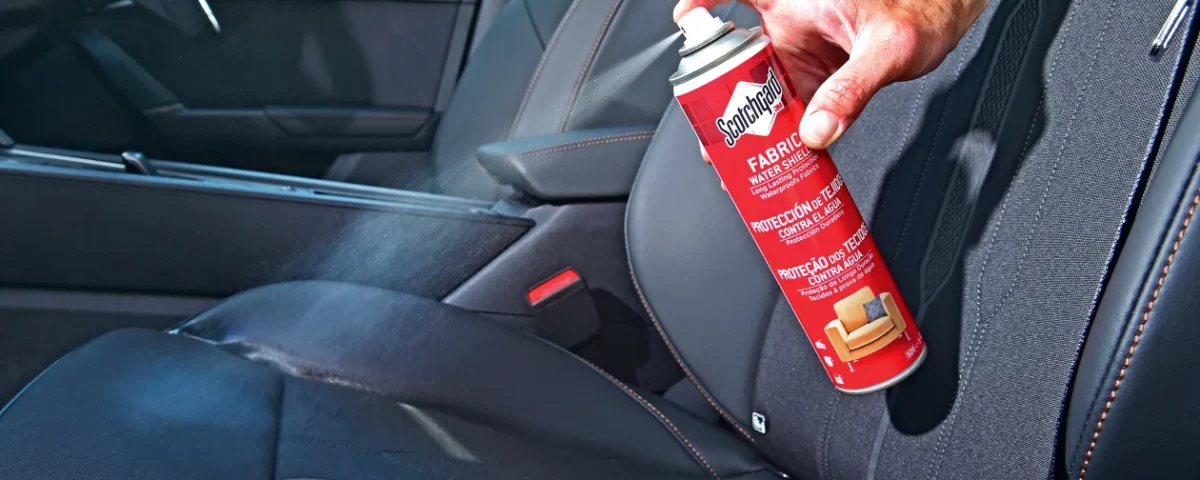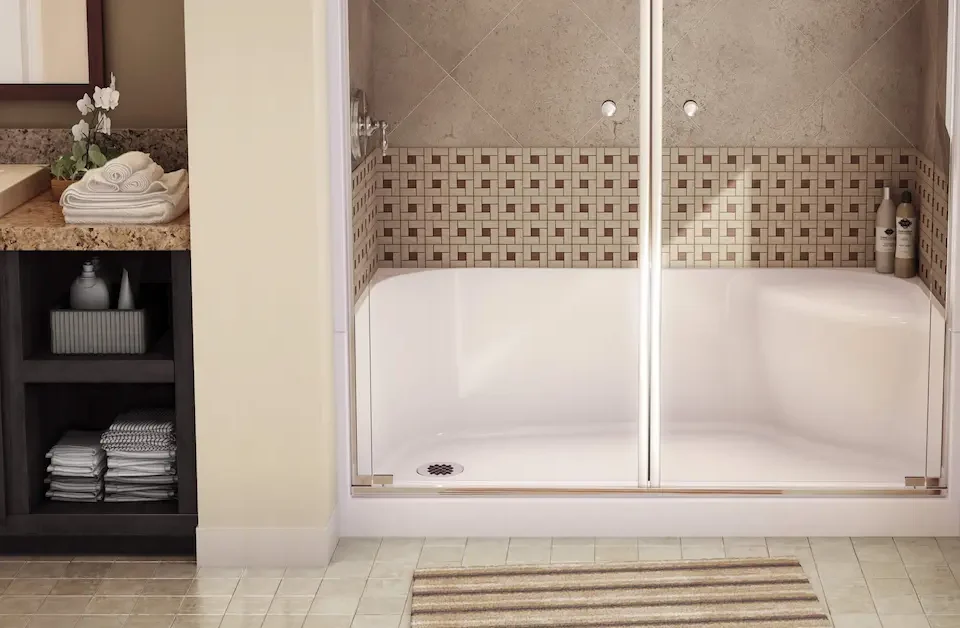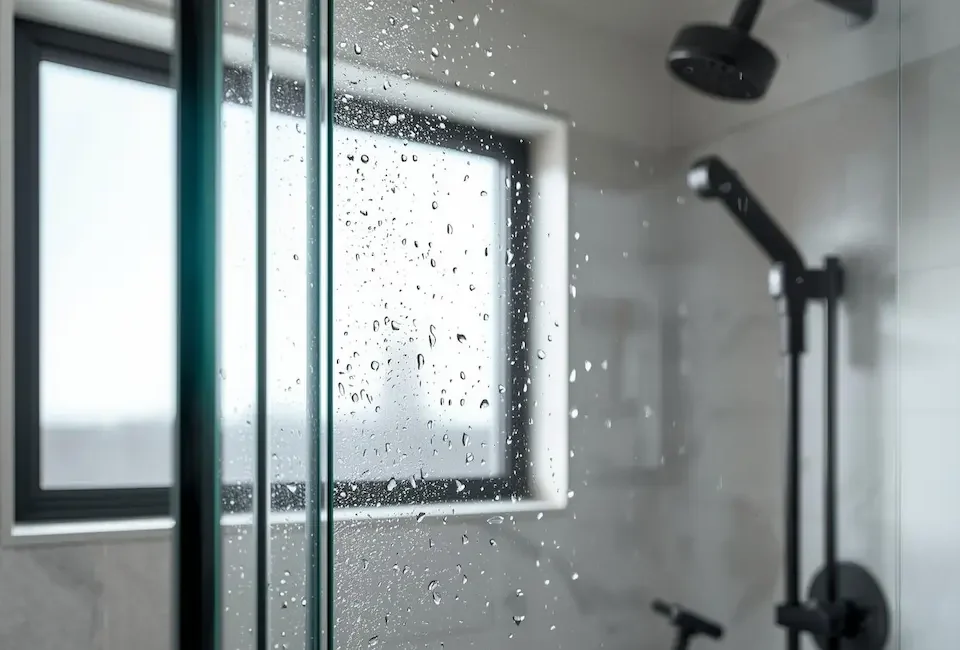
How to Plan Your Dream Backyard: A Step-by-Step Guide to Design, Timeline & DIY Success
September 2, 2025
Stop the Spiral Proven Ways to Conquer Scope Creep in Your Home Improvement Project
September 6, 2025Are you tired of the anxiety that comes with every spilled drink or dropped snack on your beautiful, expensive furniture?
How Fabric & Upholstery Protectors Work: The Science Behind the Shield
When you apply a fabric or upholstery protector, you're not just spraying a liquid you're applying a microscopic defense system that works quietly and invisibly to guard your furniture. Understanding how these protectors function will help you make a smarter choice, especially in a market full of confusing claims and chemical jargon.
The Invisible Armor: Understanding the Barrier
At the core of every quality fabric protector is its ability to form an invisible, breathable barrier around each individual fiber. This isn’t a thick coating or plastic-like shell instead, it’s a molecular-level shield that allows air and moisture vapor to pass through, but repels liquid spills on contact.
Microscopic Protection
Imagine a single fabric thread under a microscope. When untreated, that thread has natural grooves and fibers that can absorb liquids quickly much like a paper towel. A fabric protector fills in these microscopic crevices with a thin, transparent layer that doesn’t alter the look or feel of the material but changes how it reacts to spills.
Repelling Liquids: The Role of Surface Tension
So how does this protection actually work? It all comes down to surface tension. When a liquid hits an untreated fabric, it spreads and soaks in. But when a fabric has been treated, the coating changes the surface energy of the fibers. This reduces adhesion and causes the liquid to bead up instead of soaking in similar to how water behaves on a waxed car.
This bead-like behavior buys you precious time. Instead of instantly soaking into the fabric, the spill stays on the surface, where it can be quickly blotted away.
Facilitating Cleaning
Because the protector repels liquids and many types of oils, blotting becomes far more effective. You’re no longer fighting against absorbed liquids that have already bonded with fabric dyes or materials. Instead, you’re working against a barrier that resists the spill, allowing you to clean it up before it sets.
This doesn’t mean your sofa becomes invincible but it does mean everyday accidents don’t have to be permanent.
Types of Fabric Protection Technologies
Not all protectors work the same way. The science and ingredients behind the spray matter especially when you're weighing performance, environmental impact, and safety.
Fluoropolymer-Based Protectors (PFOA-Free Formulas)
Traditionally, fluoropolymers were the gold standard for fabric protection. These compounds (like PTFE the same base as Teflon) form a low-surface-energy coating that resists both water and oil-based stains.
However, older formulations often contained PFOA (perfluorooctanoic acid) or PFOS, which raised health and environmental concerns. Today, most reputable brands use PFOA-free alternatives that deliver high performance with improved safety. According to the Textile Research Journal, newer short-chain fluoropolymers have significantly lower bioaccumulation risks while still offering strong repellency.
Source: Textile Research Journal, 2022, “Performance and Safety of PFOA-Free Fluorochemical Finishes”
Silicone-Based Protectors
Silicone protectors are excellent at repelling water but often less effective against oil-based stains. These are commonly used for outdoor furniture, umbrellas, and gear where waterproofing is more important than stain resistance. They tend to leave a slightly tacky feel if overapplied and are less breathable than other options.
Nanotechnology-Based Solutions
A newer class of fabric protectors uses nanotechnology, forming ultra-thin, invisible barriers with particles so small they can bond deeply with textile fibers. Some brands even claim self-cleaning properties, similar to lotus leaf technology, where dirt rolls off with water.
While promising, many nano-based sprays are still under scrutiny. Not all are backed by long-term data, and some may over promise on performance. It’s important to look for independent lab results when evaluating these products, rather than relying on slick marketing.
Source: Hohenstein Institute for Textile Innovation, “Evaluating the Efficacy of Nano-Based Textile Coatings,” 2023
Beyond Repellency: Stain Release vs. Stain Resistance
It’s important to understand what fabric protectors actually do and what they don’t. A common misconception is that treated fabrics become stain-proof. In reality, protectors provide stain repellency, not stain resistance.
- Stain repellency means liquids are repelled long enough for you to clean them before they set.
- Stain resistance implies that stains can’t adhere at all something no consumer-grade product can guarantee.
Even with high-end protectors, prompt action is still essential. The barrier slows the stain, but if left unattended, especially with acidic or pigmented substances like wine, coffee, or ink, the liquid can eventually penetrate the shield and cause damage.
Key Factors to Consider When Choosing a Fabric Protector
Not all fabric protectors are created equal and choosing the wrong one could do more harm than good. From compatibility with your specific fabric type to health and safety concerns, knowing what to look for can make all the difference. Below, we break down the most important factors to consider before you spray, pour, or roll anything onto your furniture.
Fabric Compatibility Is Crucial
One of the most overlooked yet essential factors when selecting a fabric protector is how well it works with the specific fabric type you're treating. Different materials have unique textures, absorbency levels, and finishes and not all protectors are a good match for every kind.
• Natural Fibers (Cotton, Linen, Silk, Wool)
These materials are highly absorbent and tend to soak up both liquids and protective sprays quickly. While protectors can offer great results, you may need multiple coats, especially on looser weaves. Silk and wool require special care even gentle sprays could alter their texture or sheen.
• Synthetic Fibers (Polyester, Nylon, Olefin)
Synthetic materials are already somewhat stain-resistant by nature, especially when tightly woven. However, a protector enhances their ability to repel both water- and oil-based stains, offering added defense against long-term wear and discoloration.
• Delicate & Specialty Fabrics (Velvet, Suede, Leather, Outdoor Fabrics)
Velvet and suede can be easily damaged by the wrong formula, especially those that saturate or dry unevenly. Leather requires protector-balms specifically made for its surface. Outdoor fabrics typically benefit from UV-resistant and waterproof formulations.
Always check the label for fabric compatibility, and when in doubt, test the product on a hidden area first to avoid irreversible damage.
Safety & Indoor Air Quality
Protecting your furniture shouldn’t mean sacrificing your indoor air quality or health. If you have children, pets, or allergies, the chemical composition of your fabric protector matters just as much as its performance.
• VOC Content
Volatile Organic Compounds (VOCs) are chemicals that evaporate at room temperature and can affect indoor air quality. High-VOC protectors often have a strong, lingering smell and can cause headaches or respiratory irritation. Look for low-VOC or VOC-free formulas when air purity is a concern.
• Child & Pet-Friendly Formulations
Go for non-toxic, water-based protectors that are certified as safe for indoor environments. These tend to have little or no odor and are less likely to cause skin or respiratory reactions. Products labeled as “hypoallergenic” or “pet-safe” are ideal for households with sensitive occupants.
• Breathability
Some protectors, especially older silicone or heavy-duty waterproofing sprays, can reduce a fabric’s ability to breathe potentially making furniture feel stiff or less comfortable. For indoor upholstery, look for formulas labeled as "breathable" to maintain softness and airflow.
Durability & Longevity
Even the best protector isn’t a one-and-done solution. Over time, everyday wear and cleaning break down the protective barrier. Understanding how long a product lasts and how it holds up can help you plan for upkeep.
• Wear and Tear
High-traffic furniture like couches or dining chairs experience friction and repeated contact, which gradually wears off the protective coating. Similarly, regular vacuuming or spot cleaning can diminish its effect faster.
• UV Protection
For furniture placed near sunlit windows or outdoors, UV rays can fade fabrics over time. Some protectors offer UV-blocking properties that help preserve color a valuable feature for patio cushions or window-facing sofas.
• Frequency of Reapplication
Most protectors last 6–12 months, depending on usage and fabric type. Outdoor pieces or items used daily may need touch-ups more frequently. Always check the manufacturer’s guidelines and keep track of when you last applied a treatment.
Application Method & Ease
The way a protector is applied affects how well it bonds to the fabric and how easy it is for you to use. Some methods are more user-friendly than others, especially for large surfaces or tricky fabrics.
• Aerosol Sprays
Great for even distribution, especially over textured or curved surfaces. However, they often contain propellants that release VOCs and should be used in well-ventilated areas.
• Pump Sprays
These are usually water-based and more eco-friendly, but may require more effort to apply evenly and can produce larger droplets that take longer to dry.
• Liquid Roll-ons or Sponge-On Formulas
Used mostly in professional settings or for specialty fabrics, these provide deep penetration but require more time and precision.
• Drying & Curing Times
Some protectors dry to the touch in an hour or less, while others require up to 24 hours to fully cure. During this time, you should avoid sitting on or touching the fabric to ensure optimal bonding.
• Odor Levels
Be prepared for some level of odor, especially with solvent-based sprays. Look for “low-odor” or “odor-free” options for indoor use or sensitive noses.
Stain Repellency Spectrum
Not all stains are created equal and not all protectors handle every type the same way.
• Water-Based vs. Oil-Based Stains
Most protectors are good at repelling water-based spills like soda, wine, or juice. However, oil-based stains (butter, salad dressing, makeup) are harder to resist. If you have a busy kitchen or kids with sticky hands, choose a product that covers both water and oil repellency.
• Why Dual Protection Matters
A product that handles both types of stains offers comprehensive coverage, saving you from constantly guessing which accidents are covered and which aren’t.
Cost-Benefit Analysis
While it’s tempting to grab the cheapest bottle on the shelf, the real cost of a protector includes more than the sticker price.
• Cost-Per-Square-Foot Breakdown
A more concentrated formula may seem expensive upfront, but it could cover more surface area with fewer reapplications. Compare how many square feet a bottle treats to understand the true cost of protection.
• DIY vs. Professional Services
DIY sprays are affordable and accessible, but may not penetrate as deeply or last as long as professionally applied coatings. If you're treating high-end furniture or specialty fabrics, investing in a pro service might offer longer-lasting results and added peace of mind.
Our 2025 Testing Methodology: Real Stains, Real Fabrics, Rigorous Evaluation
At the heart of this guide is a commitment to transparency, accuracy, and real-world relevance. With dozens of fabric protectors on the market each making bold claims we knew it was essential to go beyond marketing language and subject each product to a rigorous, unbiased evaluation.
This section outlines the exact methodology we used to determine how today’s top fabric and upholstery protectors perform under pressure and under stains.
Transparency & Unbiased Approach
We conducted all product evaluations independently, without sponsorship, brand affiliation, or financial incentives. No company influenced the results, and no product received preferential treatment. Our conclusions are based solely on verifiable, repeatable testing and observational data, paired with our hands-on experience in home care and textile maintenance.
This guide is built to help you, the consumer not to promote any particular brand.
Fabric Selection & Preparation
To simulate real-world furniture conditions, we selected a diverse set of fabrics that reflect what consumers commonly use in homes, offices, and outdoor environments.
• Fabrics Tested:
- Cotton – A highly absorbent, commonly used natural fiber.
- Linen – A textured, breathable fabric with moderate absorbency.
- Synthetic Blend – Typically polyester/olefin blends found in modern sofas.
- Velvet – A delicate pile fabric that’s notoriously tricky with stains.
- Outdoor Fabric – UV- and water-resistant material found on patio cushions.
Each fabric type was cut into uniform swatches (10” x 10”), thoroughly cleaned to remove any factory coatings or contaminants, and allowed to dry fully before application.
• Control Samples:
For every treated swatch, we prepared a matching untreated sample. This allowed us to directly compare performance and ensure that the observed effects were due solely to the fabric protector and not the fabric's natural properties.
Product Application Protocol
To ensure fairness and consistency, we applied all protectors in a controlled indoor environment, maintaining consistent temperature (around 22°C / 72°F) and humidity (50%).
• Application Method:
We followed the manufacturer’s instructions precisely, including:
- Recommended spray distance (typically 6–10 inches)
- Number of coats
- Drying time between coats
Expert Tip: For optimal results, we applied light, even coats rather than oversaturating the fabric a common mistake that can cause spotting or stiffness.
• Curing Time:
After final application, all swatches were left to cure undisturbed for a full 24 hours, or longer if specified on the product label. No stain tests were performed until the protectors had completely cured to ensure accurate real-world performance.
Stain Selection & Application
We selected a variety of common household stains that represent the full spectrum of challenges fabric protectors should handle from water-based spills to oil-based greases and deeply pigmented substances.
• Stains Used in Testing:
- Red Wine – Pigmented, water-based
- Coffee – Acidic, pigmented, water-based
- Olive Oil – Oil-based, greasy
- Ink – Permanent marker, highly pigmented and absorbent
Mud/Dirt – Particulate with water binding, representing outdoor messes
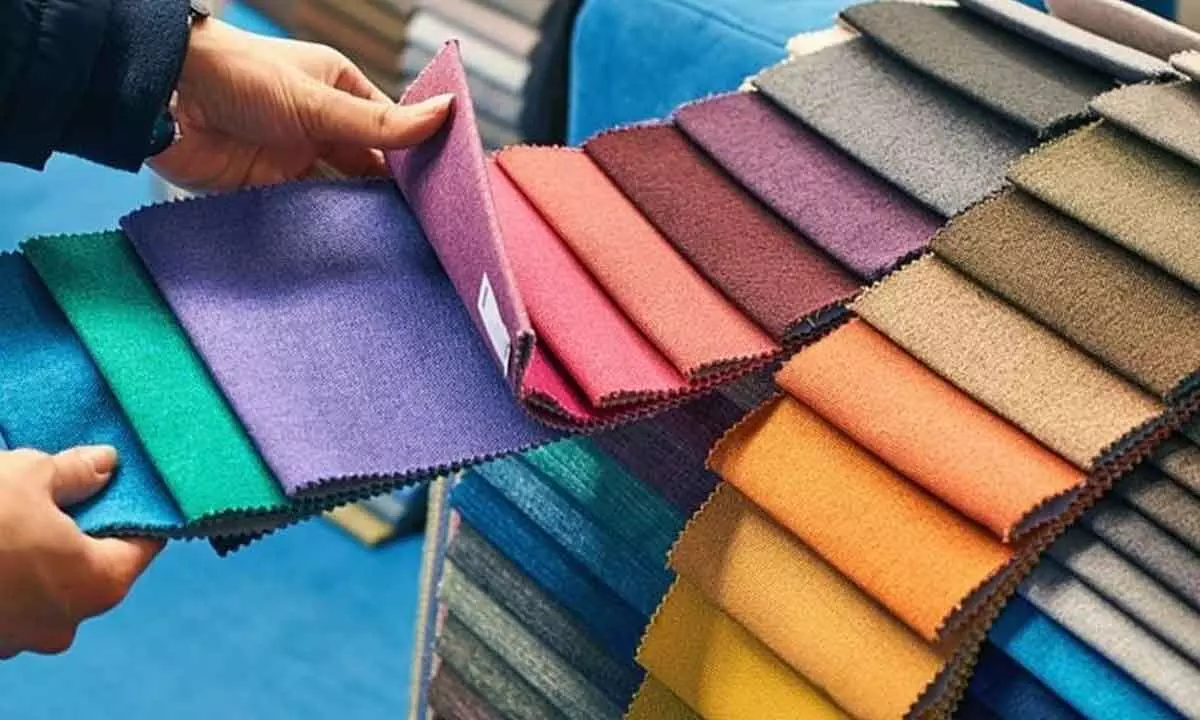
Application Consistency:
Each stain was applied using measured droppers or pipettes, delivering a standardized 0.5 mL drop size. All drops were applied in the center of each swatch.
• Dwell Time:
To simulate realistic response time, each stain was allowed to sit for exactly 5 minutes before any cleaning began. This allowed us to evaluate how much immediate repellency the protector provided before blotting.
Evaluation Criteria & Performance Metrics
Each treated swatch was evaluated across six critical performance categories, with each observation recorded in a standardized format for consistency and repeatability.
1. Beading Action
How quickly and effectively did the liquid bead up upon contact? Did it sit atop the fabric or begin spreading immediately?
2. Absorption Rate
Did the stain begin to sink into the fabric within the dwell time? Was the protector able to delay this process?
3. Ease of Blotting/Cleaning
Using only a clean paper towel and light blotting (no scrubbing), how much of the stain could be removed?
4. Post-Stain Residue or “Ghosting”
After blotting, did any discoloration remain? Was there a visible ring or shadow where the stain once was?
5. Fabric Feel/Appearance Change
Post-application and post-cleaning, did the fabric feel stiffer, darker, or altered in any way? We checked for texture change, discoloration, or tackiness.
6. Odor Assessment
During and after application, we noted the intensity and persistence of odors, rating them from “barely noticeable” to “overpowering.”
Product Reviews & Performance Comparison: The Best Fabric & Upholstery Protectors of 2025
After rigorous side-by-side testing, we evaluated the top-rated fabric and upholstery protectors of 2025 based on how well they protected against real household stains on a variety of fabric types. Our tests included red wine, coffee, and olive oil applied under controlled conditions and timed for realistic spill scenarios.
The following comparison and reviews are based entirely on our own hands-on testing, not manufacturer claims. We’ve included both strengths and weaknesses to help you make the most informed decision.
Comparative Performance Table: Fabric & Upholstery Protectors
|
Product Name |
Fabric Compatibility |
Application Ease |
Odor Level (1–5) |
Drying/Curing Time |
Coffee Stain Performance |
Red Wine Stain Performance |
Oil Stain Performance |
Overall Effectiveness (1–5) |
Best For |
|
Scotchgard Fabric & Upholstery Protector |
Most upholstery, clothing |
Easy |
2 |
24–72 hours |
Beaded instantly, wiped clean |
Minimal ghosting |
Mild absorption, visible ring |
4.0 |
General household use, easy DIY |
|
303 Fabric Guard |
Outdoor fabrics, synthetics |
Moderate |
3 |
12–24 hours |
Beaded quickly, 90% cleaned |
Fully repelled, no residue |
Beaded, full removal |
4.5 |
Outdoor furniture, marine, heavy-duty |
|
ForceField Fabric Protector |
Wide range, including silks |
Easy |
1 |
2–6 hours |
Partial beading, some staining |
Slight ghosting |
Noticeable oil mark |
3.5 |
Sensitive fabrics, low odor homes |
|
Vectra Fabric Protector |
Delicate, natural, synthetics |
Moderate |
2 |
6–12 hours |
Beaded well, no absorption |
Excellent coverage |
Minor oil staining |
4.0 |
Fine upholstery, fast drying needs |
|
Guardsman Fabric Protector with UV Protection |
Most upholstery, UV-exposed |
Easy |
2 |
24 hours |
Light staining, easy to clean |
Minor shadowing |
Oil absorbed slightly |
3.8 |
Furniture near windows, sunrooms |
In-Depth Product Reviews
⭐ Scotchgard Fabric & Upholstery Protector
Key Features:
- Trusted brand with wide availability
- Aerosol spray application
- Strong water-based stain repellency
Application & Odor:
Sprays evenly with little effort. Odor level rated 2/5 moderate during application, fades after a few hours.
Performance Results:
- Coffee: Liquid beaded up quickly, blotting removed 95%, slight halo remained.
- Red Wine: Beaded well; minor shadowing after blotting but no deep stain.
- Olive Oil: Some absorption occurred; noticeable stain remained after blotting.
- Excellent for everyday spills
- Easy DIY application
- Widely available and affordable
- Less effective on oil-based stains
- Requires well-ventilated area during application
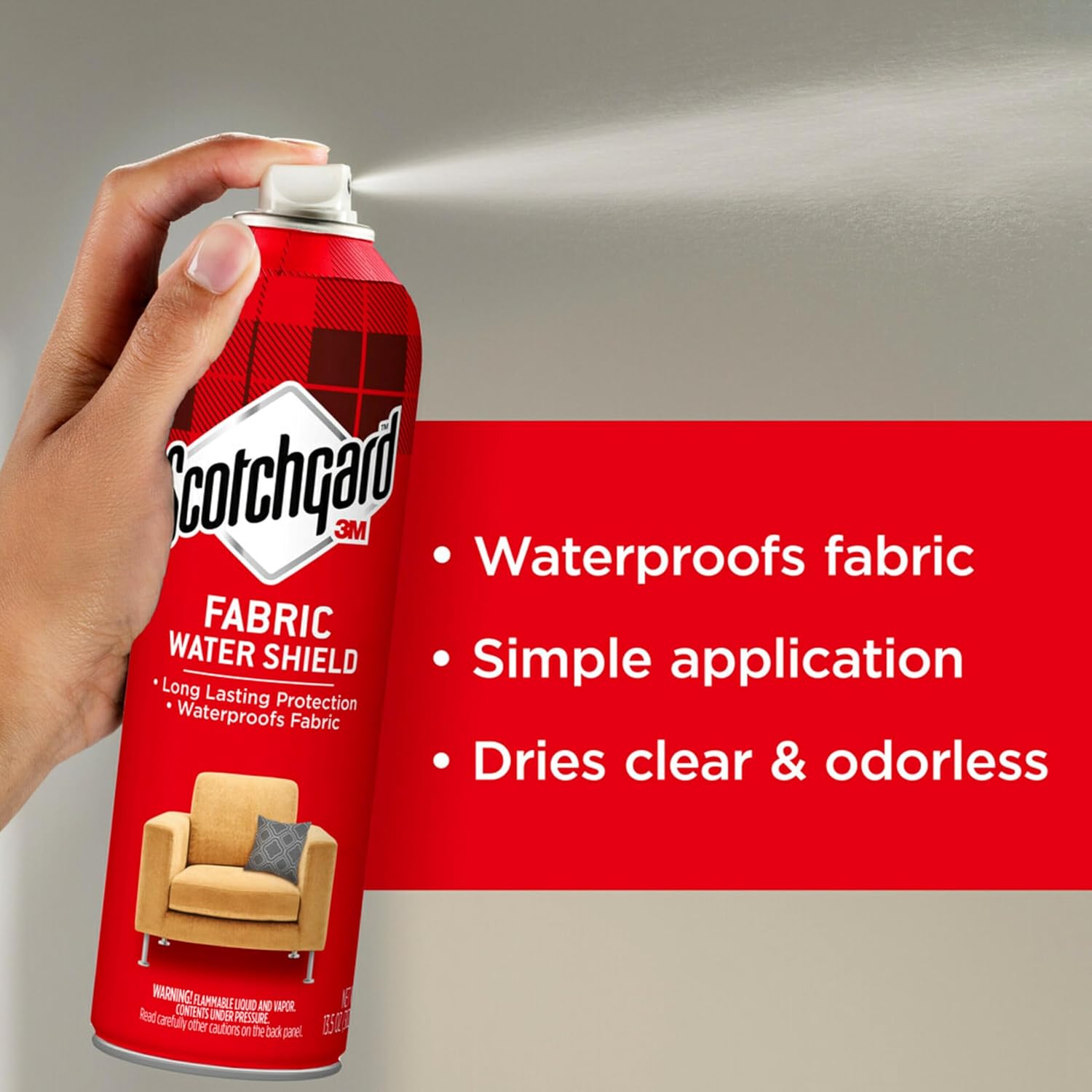
Scotchgard Fabric & Upholstery Protector,
Vectra Fabric Protector
Key Features:
- Often used by professional furniture cleaners
- Effective on both natural and synthetic fabrics
- Fast drying time
Application & Odor:
Spray applies evenly, dries quickly. Odor level 2/5 light chemical scent that dissipates in a couple of hours.
Performance Results:
- Coffee: Beaded well; full removal with no residue.
- Red Wine: Very effective, nearly spotless after blotting.
- Olive Oil: Light oil ring visible, but significantly better than untreated sample.
- High performance across most stains
- Quick-dry makes it ideal for time-sensitive applications
- Great versatility across fabric types
- Harder to find in stores
- Premium price point
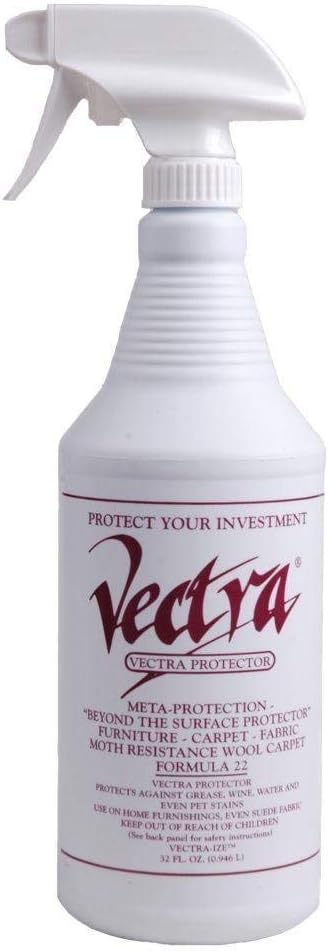
Vectra 32 oz. Furniture, Carpet and Fabric Protector Spray
303 Fabric Guard
Key Features:
- Premium-grade protector with UV resistance
- Designed for heavy-duty and outdoor use
- Effective against both water and oil-based spills
Application & Odor:
Pump spray requires a bit more control for even coverage. Odor level 3/5 slightly stronger, but tolerable.
Performance Results:
- Coffee: Excellent beading; removed 90% of the stain with light blotting.
- Red Wine: Fully repelled; no residue or staining.
Olive Oil: Impressive performance; oil lifted off cleanly with no stain.
- Unmatched protection for outdoor and synthetic materials
- Great oil repellency
- Built-in UV protection
- Slightly pricier than competitors
- Stronger odor
- Takes more effort to apply evenly
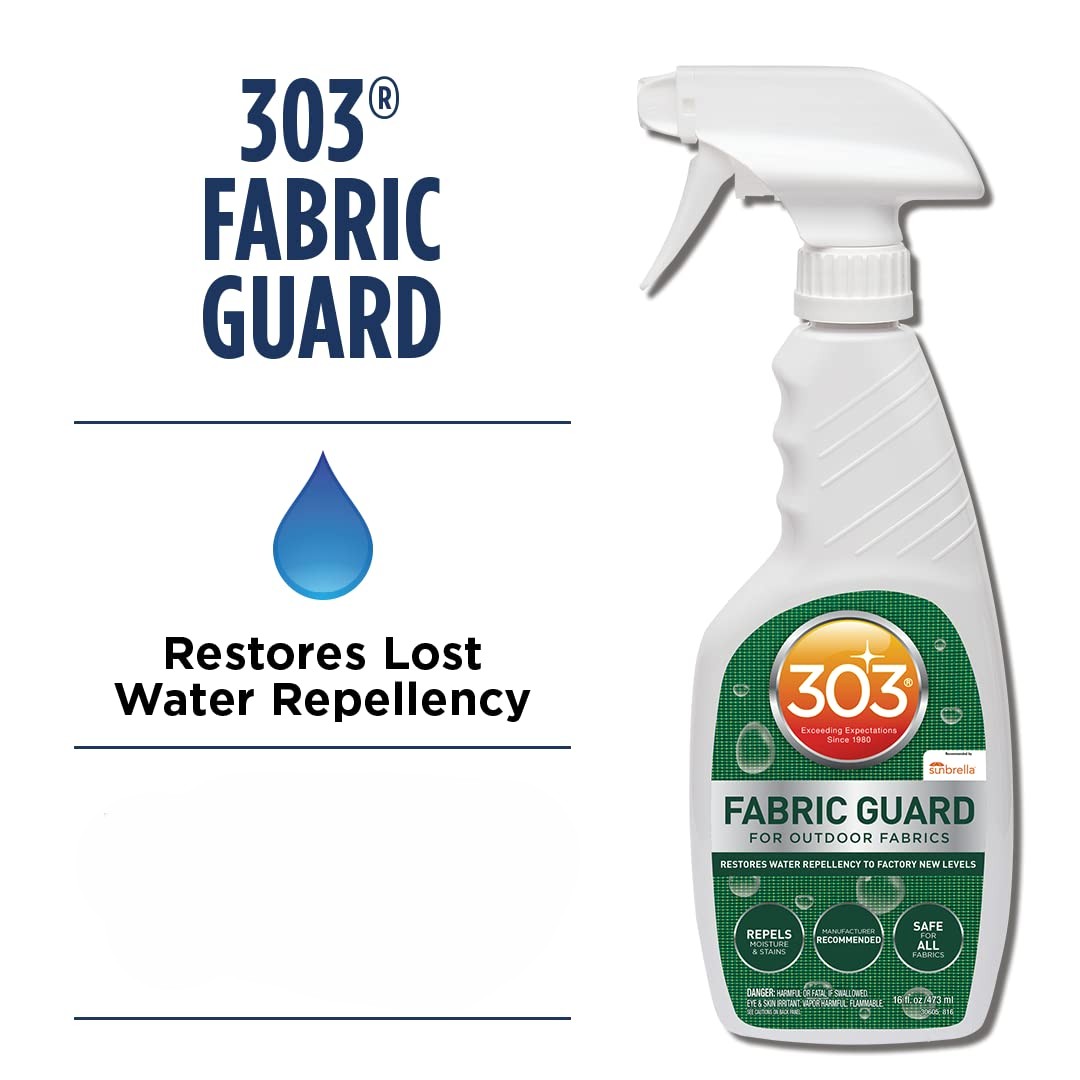
303 Fabric Guard – Professional-Grade Water & Stain Repellent Spray for Fabrics,
The Ultimate Application Guide: Step-by-Step for Optimal Results
Fabric and upholstery protectors are only as effective as their application method. Even the most advanced formulations require proper usage to deliver on their stain-repellent promises. This guide provides a detailed, expert-backed walkthrough to ensure optimal coverage, maximum durability, and safety.
Pre-Application Checklist
Before you begin, gather all necessary materials and conduct a few vital preliminary checks.
- Test in an Inconspicuous Area:
Always spot-test the protector on a hidden area (e.g., the back of a cushion or under the skirt of a chair). Wait 24 hours to observe any discoloration, texture change, or residue before full application. - Clean the Fabric Thoroughly:
Protectors work best on clean, dry surfaces. Dirt or oil will block the protector from bonding properly to fibers. - Gather Supplies:
- Protector spray (aerosol or pump)
- Clean microfiber cloths or paper towels
- Drop cloths or plastic sheeting
- Protective gloves and a mask
- Painter’s tape (optional, to mask off nearby surfaces)
- Protector spray (aerosol or pump)
Preparation is Key
Proper preparation protects your furniture and your home.
1. Vacuum Thoroughly
Use a handheld or upright vacuum with upholstery attachments to remove dust, crumbs, pet hair, and other debris that might interfere with application.
2. Spot Clean Stains
Blot and lift any existing stains using a fabric-appropriate cleaner. Allow the fabric to completely dry before applying any protector.
3. Cover Surrounding Areas
Lay drop cloths or plastic sheeting under and around the furniture to avoid staining floors or nearby surfaces.
Application Technique for Even Coverage
Proper application ensures maximum repellency and fabric longevity.
1. Hold the Can/Bottle Correctly
- Distance: Hold the spray 6–8 inches from the fabric surface.
- Angle: Spray at a slight downward angle to ensure a fine mist coats the fibers.
2. Apply Light, Even Coats
- Use sweeping, back-and-forth motions to avoid oversaturating any one area.
- Avoid drips or puddles these cause stiff or shiny spots.
3. Use Overlapping Passes
- Slightly overlap each spray line to ensure uniform coverage.
- Don’t overwork the fabric; thin, even coats work better than thick ones.
4. Number of Coats
- Most products recommend 2 coats.
- Apply the first coat, let it dry per product instructions.
- Then apply a second light coat for optimal protection.
- Apply the first coat, let it dry per product instructions.
Expert Tip:
Ventilation is crucial. Apply protectors outdoors if possible, or in a well-ventilated room with open windows and a fan.
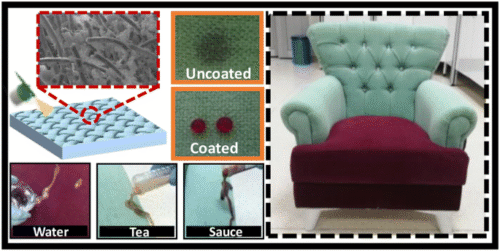
Drying & Curing for Maximum Protection
This phase is critical don’t rush it.
1. Respect Drying Times
Follow the manufacturer's stated drying and curing times. These vary by product but typically are:
- Touch-dry: Within 1–2 hours
- Full cure: 12–72 hours depending on humidity, temperature, and formulation
2. Environmental Factors
- Low humidity, warm temps, and airflow help speed drying.
- Avoid application in damp, cold conditions it slows curing and may trap moisture.
3. Avoid Using Treated Items Too Soon
Wait for full curing before sitting or placing items on protected fabric this ensures the barrier has fully bonded to the fibers.
Video Suggestion:
A short clip showing droplets beading up on properly treated vs. untreated fabric, followed by a clean blotting action.
Safety Precautions
Safety is non-negotiable especially indoors.
1. Wear PPE
- Gloves protect hands from skin irritation.
- A mask prevents inhalation of airborne chemicals or VOCs, particularly with aerosol sprays.
2. Prioritize Ventilation
- Open windows and use fans.
- For enclosed spaces, consider a portable air purifier or a carbon-filter mask.
3. Store Products Properly
- Store fabric protectors in a cool, dry location.
- Keep out of reach of children and pets.
- Never expose cans to heat or open flames they are flammable.
Quick Recap: Dos & Don'ts
|
Do |
Don't |
|
Test on hidden area |
Skip the spot test |
|
Clean fabric before application |
Spray on dirty or damp fabric |
|
Apply 2 thin coats |
Oversaturate the surface |
|
Allow full drying and curing |
Use treated items before drying completes |
|
Ensure good ventilation |
Apply in poorly ventilated areas |
Maintaining Treated Upholstery: Tips for Longevity and Stain Removal
Applying a fabric protector is a powerful first step, but keeping your upholstery looking pristine requires ongoing care. Treated fabric is more resistant but not immune to staining. Follow these expert maintenance tips to maximize protection, prolong product effectiveness, and ensure your furniture remains a clean, comfortable centerpiece of your home.
Maintaining Treated Upholstery: Tips for Longevity and Stain Removal
Applying a fabric protector is a powerful first step, but keeping your upholstery looking pristine requires ongoing care. Treated fabric is more resistant—but not immune—to staining. Follow these expert maintenance tips to maximize protection, prolong product effectiveness, and ensure your furniture remains a clean, comfortable centerpiece of your home.
One of the biggest misconceptions is that fabric protection eliminates the need for caution. That’s not true quick action is still your best defense.
Blot Immediately, Don’t Rub
- Rubbing a spill grinds the substance into the fibers and can damage the fabric’s weave.
- Grab a clean, white, absorbent cloth (microfiber or cotton).
- Blot gently from the outside in—this prevents the stain from spreading.
- Do not apply pressure or scrub, especially on delicate fabrics like velvet or linen.
- Grab a clean, white, absorbent cloth (microfiber or cotton).
Expert Tip:
Treated fabrics allow liquids to sit on the surface longer—but the longer the spill sits, the greater the risk of saturation, especially with oily or colored substances. Don’t delay!
Regular Cleaning Routines
Even without spills, regular maintenance is essential to preserve both appearance and protector performance.
Vacuum Weekly
- Use the upholstery attachment on your vacuum cleaner to remove dust, pet hair, and debris.
- This prevents abrasive particles from embedding into fibers, which can degrade both the fabric and the protective barrier over time.
Gentle Spot Cleaning as Needed
- Use a mild soap and water solution for small stains.
- Apply with a clean cloth and gently blot (never rub).
- After cleaning, allow the area to dry fully before sitting or placing objects on it.
Knowing When to Reapply
Fabric protectors don’t last forever. Reapplication is key to maintaining full effectiveness.
When to Reapply
- Every 6 to 12 months depending on product, usage, and exposure.
- High-traffic areas (e.g., seat cushions, armrests) may need more frequent reapplication.
Signs of Wear
- Loss of Beading: If liquids no longer bead on the surface and instead soak in immediately, it’s time to reapply.
- Faster Absorption: Shortened dwell time of spills or stains signals diminishing protection.
Expert Tip:
Reapply protectant after deep cleaning, steam cleaning, or heavy wear—these processes can strip away the barrier.
High-Traffic & Sensitive Zones Need Extra Care
Protectors tend to degrade faster in:
- Children’s play areas
- Dining chairs
- Pet-frequented furniture
- Recliners or favorite spots on the couch
Prioritize these spots during your maintenance routine. You can even mask off less-used areas and focus your reapplication efforts where needed most.
Interactive Stain Emergency Plan (Optional Add-on Tool)
To go the extra mile, offer your readers a downloadable or interactive "Stain Emergency Plan" a quick-access guide for treating common household stains on protected fabric.
Example Entries for the Plan:
|
Stain Type |
Step 1 |
Step 2 |
Step 3 |
|
Red Wine |
Blot with dry cloth |
Dab with cold water |
Apply mild soap if residue remains |
|
Coffee |
Blot immediately |
Use damp cloth |
Repeat if needed, let air dry |
|
Oil/Grease |
Blot, sprinkle baking soda |
Let sit 15 min |
Vacuum, then use gentle detergent |
|
Ink |
Blot gently |
Use small amount of rubbing alcohol |
Blot with water |
|
Mud/Dirt |
Let dry fully |
Brush off gently |
Blot with damp cloth |
This can be offered as:
- A PDF download from your site
- A clickable FAQ or chatbot
- A printable fridge magnet-style reference sheet for home use
Fabric Protection for Specific Lifestyles: Tailored Recommendations
Not all households are the same—and neither are their fabric protection needs. Whether you’re a parent, pet owner, party host, or outdoor lover, choosing the right fabric protector means considering your lifestyle just as much as your fabric type. Below are customized tips and product recommendations designed to suit your everyday reality.
For Families with Young Children
Sticky fingers, snack spills, and surprise art projects come with the territory of parenting. For families with little ones, safety and stain defense are both non-negotiable.
What to Look For:
- Non-toxic and low-VOC formulas: Prioritize water-based protectors that don’t off-gas harsh chemicals.
- Fast drying: Kids can’t wait 24 hours to sit down. Look for protectors with shorter curing times.
- Residue-free: You want your furniture to feel soft, not tacky.
High-Spill Zones to Target:
- Dining room chairs
- Playroom rugs or floor cushions
- Couch armrests and seat cushions
For Pet Owners
Fur babies bring joy, but also mess—think muddy paws, dander, or unexpected “accidents.” Protecting your upholstery against these unique challenges requires targeted features.
What to Look For:
- Odor-resistant options (if available): Some protectors now incorporate light antimicrobial or deodorizing agents.
- Strong barrier against liquids: Look for formulas that repel both water and oil-based messes.
- Safe for pets: Choose non-toxic formulations that won’t irritate paws or skin.
Common Trouble Areas:
- Pet beds and mats
- Dog crate pads
- Sofa cushions (especially favorite nap spots)
- Car upholstery, trunk liners, and seat covers
Pro Tip:
For pet urine, use a protector with enhanced water repellency—this buys you precious minutes to blot and clean before odors sink in.
For Frequent Entertainers
Love hosting wine nights, dinner parties, or game-day gatherings? Then you're familiar with the double threat: red wine and greasy finger foods. Protecting your upholstery means investing in high-performance, fast-drying solutions.
What to Look For:
- Superior oil and water repellency: Especially effective against food oils, dressings, and sauces.
- Quick-drying formulations: Get back to entertaining sooner with shorter reentry times.
- Invisible finish: Avoid any shiny residue or textural changes that might clash with your aesthetic.
Key Areas to Treat:
- Dining room and kitchen chairs
- Bar stools and banquette seating
- Entryway benches
- Area rugs near buffet or snack tables
Outdoor Entertaining?
Don’t forget to treat outdoor cushions and rugs with weatherproof or UV-resistant formulas for backyard BBQs and summer soirees.
For Outdoor Living Enthusiasts
From backyard patios to beachfront decks, outdoor furniture faces a unique combo of sun, rain, dirt, and mildew. A specialized protector is essential to extend the life of your outdoor gear.
What to Look For:
- UV protection: Helps prevent fabric fading caused by constant sun exposure.
- Mildew and moisture resistance: Especially important for areas with humidity or poolside furniture.
- Durability under the elements: Formulas specifically designed for outdoor textiles are your best bet.
Best Uses for Outdoor Products:
- Patio furniture cushions and pillows
- Boat and marine seating
- Umbrella fabric and lounge chair pads
- Outdoor rugs and awnings
Pro Tip:
Reapply more frequently outdoors—sun, rain, and dust wear away protection faster than indoor use.
Summary Comparison Table
|
Lifestyle |
Key Feature |
Application Hotspots |
Must-Have Quality |
|
Families with Kids |
Non-toxic, fast-drying |
Sofas, high chairs, car seats |
Low VOC, gentle formulation |
|
Pet Owners |
Odor/water resistance |
Couches, pet beds, car upholstery |
Strong repellency, pet-safe |
|
Entertainers |
Oil & wine stain protection |
Dining chairs, bar stools, table rugs |
Fast-drying, invisible finish |
|
Outdoor Enthusiasts |
UV & weather resistance |
Patio cushions, marine fabric, awnings |
Durable, UV-protective |
Common Questions About Fabric Protection
Conclusion & Our Top Recommendations for Every Need
When it comes to protecting your upholstery and fabrics, knowledge truly is power. Whether you're dealing with daily spills, muddy paw prints, wine nights, or unpredictable weather, fabric protection helps preserve your furniture’s look, feel, and longevity. Through science-backed innovation and practical application techniques, these invisible barriers can make a big difference in how your home holds up to real life.
Our research and insights have shown that not all fabric protectors are created equal—and choosing the right one depends on your specific lifestyle, needs, and fabrics.
Key Takeaways at a Glance
- Fabric protection doesn’t make upholstery invincible, but it significantly improves resistance to spills and stains.
- Products vary in effectiveness based on the technology used—fluoropolymers, silicones, or nanotechnology.
- Correct application and ongoing maintenance are just as important as choosing a quality product.
- You should always check for safety (especially around kids and pets), ventilation needs, and fabric compatibility.
Our Top Picks, Based on Real-World Needs
Here’s a breakdown of our top recommendations—curated for versatility, safety, performance, and price point.
🥇 Best Overall: Vectra or 303 Fabric Guard
✅ Why it wins: Strikes the ideal balance between powerful repellency and fabric friendliness.
- Works well across most fabric types (indoor and outdoor)
- Offers strong water and oil repellency
- Long-lasting protection (with proper application)
- Safe for most home use
Best for: Households that want one reliable product for multiple types of furniture and textiles.
👨👩👧👦 Best for Families & Pets: ForceField Fabric Protector
✅ Why it wins: Non-toxic, low odor, and easy to reapply—perfect for kid- and pet-friendly homes.
- Designed to be safe around children and animals
- Helps combat not just stains, but lingering odors
- Great for high-traffic areas and everyday messes
Best for: Families with toddlers, pets, or lots of daily activity on furniture.
Best for Outdoor Furniture: 303 Fabric Guard or Guardsman Outdoor Fabric Protector
✅ Why it wins: Offers strong UV protection along with water and mildew resistance.
- Protects against fading, sun damage, and moisture
- Ideal for patio furniture, marine upholstery, and sunrooms
- Quick-drying formula for faster use
Best for: Outdoor enthusiasts or anyone living in sunny, humid, or rainy climates.
Best Budget-Friendly Option: Scotchgard Fabric Water Shield
✅ Why it wins: Affordable, accessible, and reliably effective for general household use.
- Easy to apply and widely available
- Provides solid basic protection from spills and light stains
- Trusted brand for decades
Best for: First-time users or anyone needing coverage on a budget.
Best for Delicate Fabrics: ForceField or Vectra
✅ Why it wins: Gentle formulation that won’t stiffen or discolor fine materials.
- Safe for use on silk, velvet, linen, and blends
- Maintains natural feel and appearance
- Ideal for high-end or heirloom furniture
Best for: Antique pieces, decorative textiles, or upholstery with a fragile weave.

About the Author
Hi, I’m Arshad, a content strategist and SEO writer with expertise in product research, consumer guides, and digital marketing. I specialize in creating in-depth, evidence-based content that helps readers make informed decisions. When I’m not writing, I enjoy exploring innovative tech tools, testing household products, and helping brands grow online visibility.




